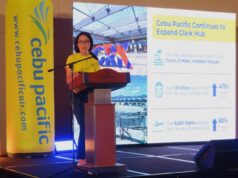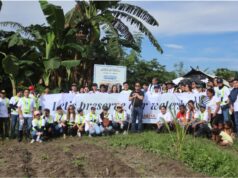Clockwise, from top left: Liza Reyes, Globe Head of Public Relations and Communications Strategy; Arnold Salaverria, Globe Senior Director and Program Lead for Wired Broadband; Levi Lopez, Globe VP and Program Lead for Wireless Upgrades; Yoly Crisanto, Globe SVP for Corporate Communications and Chief Sustainability Officer; Eula Ulanday, Globe Director and Program Lead for Wireless New Site Build
Globe continues to expand its fiber footprint in Northern and Central Luzon, with capacity expected to grow three times by the end of the year. The company’s high-speed broadband is now present in 70 percent of the provinces in the area.
As of the third quarter, Globe has built 271 percent more fiber to the home (FTTH) than the entire 2020 in Northern and Central Luzon. It is on track to reach 315 percent by December 31.
“One of the best options that Globe can offer our customers is fiber lines or broadband at home. We are happy to note that this is a remarkable year. In Northern and Central Luzon, we have built almost three times the number we had in 2020,” announced Arnold Salaverria, Globe Senior Director and Program Lead for Wired Broadband.
Many of the builds were in Bulacan, Pampanga, Ilocos, Tarlac, La Union, and Nueva Ecija, among other provinces. The company has big plans in 2022 for those not yet covered by fiber lines.
Salaverria also expressed gratitude to the local government units (LGUs), local cooperatives, and Homeowners Associations (HOAs) that allowed Globe to install fiber to communities in Northern and Central Luzon.
“North Luzon is one of the areas where FTTH is doing well in terms of getting permits. We are grateful to HOAs, LGUs, and local cooperatives who are one with the Bayanihan Act and are joining Globe in bringing the internet closer to the homes of Filipinos,” he said.
Salaverria added that there was also a significant improvement in the issuance of permits from the local coops, such as power cooperatives whose electric poles are needed by Globe to put up cable lines and make broadband more accessible. However, the company still faces challenges from the HOAs of some private subdivisions which do not allow Globe to enter, especially when there are exclusive contracts with other telcos.
“We would like to ask for the same support from other villages whose permits take longer to secure. Some of our builds are pending because of this. We enjoin our HOAs to also be instrumental in bringing more choices for connectivity to their neighborhoods especially at a time when the internet is crucial for education, livelihood, and basic services,” he said.
Globe’s efforts to make broadband connectivity accessible to households and businesses in more areas received a major boost after it completed its target of one million fiber lines in September of this year, three months ahead of schedule. Fiber provides high-speed internet to customers, allowing them to download or upload large files faster and stream high-definition videos and webinars, to name a few of its benefits and advantages.
Globe strongly supports the United Nations Sustainable Development Goals, particularly UN SDG No. 9, highlighting the roles of infrastructure and innovation as crucial drivers of economic growth and development. The company also champions the UN Global Compact principles and contributes to 10 UN Sustainable Development Goals.
To know more about Globe, visit www.globe.com.ph.





